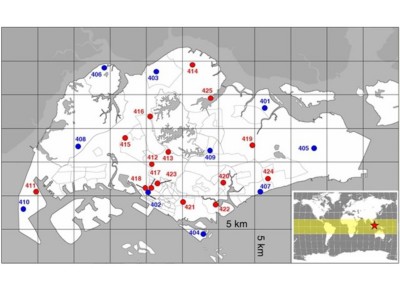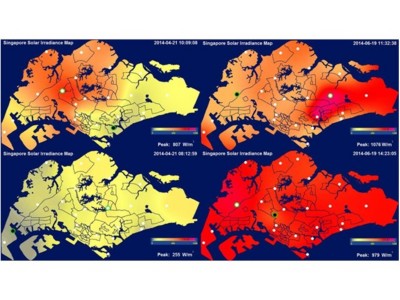SERIS Creates Rugged Network of Remote Meteorological Stations
Mark Kubis - Solar Energy Research Institute of Singapore (SERIS)
Andre Nobre - Solar Energy Research Institute of Singapore (SERIS)

"Constantly hot and humid Singapore weather poses extra challenges for remote monitoring components. With rugged NI hardware, SERIS built an extremely tough system that features greater than 99.8 percent availability for its research data throughout a vast amount of stations on the island."
- Mark Kubis, Solar Energy Research Institute of Singapore (SERIS)
The Challenge
Mapping Singapore’s ground solar irradiance in real-time for solar resource assessment and forecasting in PV applications.
The Solution
Creating a network of remote meteorological stations based on CompactRIO hardware that are placed throughout the country and monitored on a PC running LabVIEW system design software.
With the continuous growth of solar photovoltaic (PV) installations worldwide, this renewable form of energy is contributing more and more towards energy matrices around the world. Due to its intermittent nature caused by constantly changing cloud coverage and weather conditions, a tropical location such as Singapore poses extra challenges for utilities wanting to integrate this renewable energy source with existing fossil fuel power generation capacities.
With its research project on solar irradiance assessment and forecasting, SERIS has deployed a comprehensive network of meteorological stations throughout the country-state island on a 5 km by 5 km grid. All remote stations run systems using CompactRIO hardware coded using NI LabVIEW software. Acquiring key meteorological parameters utilizes algorithm development in the search for short-term and intraday irradiance forecasts, which later can be used to predict PV electricity production patterns. Additionally, year-round solar resource measurements help create seasonal and annual irradiation maps for the country.
Hardware
On the front end, 25 remote stations deployed in the field run on cRIO-9075 real-time controllers. The stations contain an NI 9203 C Series analog current input module and an NI 9217 C Series RTD module connected to relevant meteorological sensors, such as global and diffuse solar irradiance; ambient temperature; relative humidity; wind speed and direction; and air pressure. At the back end, hosted at the SERIS PV Systems Monitoring Laboratory, the central monitoring station (CMS) PC runs software based on LabVIEW and interfaces with the remote stations in the field via a 3G network in real time.
System Description
The entire system is configured to perform the following series of tasks:
- Remote logging—All data is sampled at 1 Hz and logged at one-minute intervals at each of the remote stations
- Data collection—All remote station communication with the CMS takes place via a 3G Internet network, transmitting both in real time (every second and every minute) and in “research packets” (prepared data for scientists at the end of every day)
- Data storage—Data is stored in binary format for fast transfer and processing in databases and statistical agents
- Data publishing services—Researchers can easily tap into historical data sets that can be automatically set or manually prepared
- Alarm checks—The CMS monitors station health through “heartbeats” received every minute, reporting system-critical characteristics such as transmission status, memory levels, and CPU usage
- Time synchronization—The system applies a time-correction routine every time a CompactRIO clock drifts beyond 300 ms from the SERIS high-precision time server
Key Monitoring Infrastructure Characteristics and Highlights
Constantly hot and humid Singapore weather poses extra challenges for remote monitoring components. With rugged NI hardware, SERIS built an extremely tough system that features greater than 99.8 percent availability for its research data throughout a vast amount of stations on the island. The system also offers seamless time synchronization. All of the CompactRIO systems deployed in the field are synchronized to a dedicated time server in the institute. This guarantees a maximum drift between clocks of 300 ms, which is paramount for research in the correlation of spatially distributed stations. Additional key features of the system include:
- Remote diagnostics—Stations deployed in the field can be adjusted remotely for tasks such as software updates
- Alarm functions (system)—Alarms monitor station health
- Alarm functions (sensors) —Extra statistical routines written using LabVIEW perform checks for parameter ranges, minimizing downtime if a sensor fails in the field
- Autodownload routines—Research data downloads every day after sunset, so scientists can readily work on new algorithms
- Data on demand—Scientists and engineers can easily retrieve data when needed
- Real-time system visualization capabilities—One-second “live” data displays are available as user interfaces (or “players”) to any PC connected to the Internet
Live Irradiance Map Creation
After data arrives at the CMS from the remote stations, scientists can run calculations, plots, and algorithms by tapping into tailored databases. Additionally, by selecting and grouping live data into subsets in real time, using custom-designed LabVIEW software, SERIS created live solar irradiance mapping capabilities, which are then made available through the user interface at the SERIS PV Systems Monitoring Laboratory. Irradiance readings from 25 stations are extracted within one second and made available for a color interpolation algorithm. The map updates every two to three seconds, depending on network transmission delays. Using the map interactive feature, scientists can read irradiance values at a given cursor position as well as at a location chosen by entering a postal code.
The map also shows maxima and minima integrated and average irradiance values over the entire Singapore land area.
For a public display, SERIS uploads the irradiance maps on the National Solar Repository of Singapore (NSR, www.solar-repository.sg), a government initiative to promote the use of solar PV in Singapore.
SERIS System Benefits
SERIS is at the forefront of state-of-the-art research in solar cells, modules, systems, and energy-efficient buildings tailored for tropical regions. Its PV grid integration research efforts are facilitated through the comprehensive network of remote meteorological stations described here. The remote monitoring network runs on NI hardware and software, guaranteeing excellent data availability and reliability for SERIS researchers and engineers, and in the near future, other stakeholders, such as public utilities.
Through this rugged, spatially-resolved network of meteorological stations, SERIS researchers are able to develop forecast algorithms to predict solar energy resources ahead of time for PV applications. With the massive adoption of solar PV throughout the world, especially in new, untapped markets in the tropics and other developing countries, it is only a matter of time before renewable energy systems such as PV contribute considerably to electricity grids everywhere, and, in the process, make use of powerful and comprehensive remote data monitoring capabilities to gather additional parameters needed to smoothly integrate variable energy sources.
Author Information:
Mark Kubis
Solar Energy Research Institute of Singapore (SERIS)
National University of Singapore (NUS) 7 Engineering Drive 1 Block E3A, #06-01
117574
Singapore
mark.kubis@nus.edu.sg
Next Steps
Products in This Case Study
